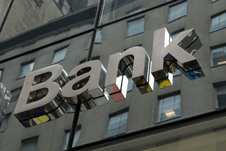Types of Bank Accounts
Depository institutions may offer a great variety of accounts, but they generally fall within one of these five types of bank accounts:
Checking Accounts
A checking account is a type of bank account from which you use checks to withdraw your money. You may use checks to pay your bills, purchase products and services (at businesses that accept personal checks), send money to friends and family, and many other common uses. You can also use checks to transfer money into accounts at other banks and financial institutions. You have quick, convenient, and, if needed, frequent-access to your money. Typically, you can make deposits into the checking account as often as you choose. Many banking institutions will enable you to withdraw or deposit funds at an automated teller machine (ATM) or to pay for purchases at stores with your ATM card.
Some checking accounts pay interest; others do not. A regular checking account - frequently called a demand deposit account - does not pay interest, while a negotiable order of withdrawal (NOW) checking account does.
Banks and financial institutions may impose fees on checking accounts, besides a charge for the checks you order. Fees vary among banks. Some institutions charge a bank account maintenance or flat monthly fee regardless of the balance in your checking account. Other institutions charge a monthly fee if the minimum balance in your checking account drops below a certain amount any day during the month or if the average balance for the month drops below the specified amount. Some banks charge a fee for every transaction in your bank account, such as for each check you write or for each withdrawal you make at an ATM. Many institutions impose a combination of these banking fees.
Although a checking account that pays interest may appear more attractive than one that does not, it is important to look at fees for both types of checking accounts. Often checking accounts that pay interest charge higher bank fees than do regular checking accounts, so you could end up paying more in fees than you earn in interest.
Money Market Accounts
Most banks and financial institutions offer a type of interest-bearing account that allows you to write checks called a money market account. This type of bank account usually pays a higher rate of interest than a checking or savings account does. Money market accounts often require a higher minimum balance to start earning interest, but they frequently pay higher rates for higher balances. Withdrawing funds from a money market account may not be as convenient as doing so from a checking account. With a money market account, each month, you are limited to six transfers to another account or to other people, and only three of these transfers can be by check. As they do with checking accounts, most banks and financial institutions impose fees on money market accounts.
Savings Accounts
Another type of bank account, a savings account, allows you to make withdrawals, but without the flexibility of using checks to do so. As with a money market account, the number of withdrawals or transfers you can make on the savings account each month is limited.
Many banking institutions offer more than one type of savings account -- for example, passbook savings and statement savings. With a passbook savings account you receive a record book in which your deposits and withdrawals are entered to keep track of transactions in your savings account; this record book must be presented when you make deposits and withdrawals. With a statement savings account, the bank regularly mails you a statement that shows your withdrawals and deposits for the savings account.
As with other types of bank accounts, a bank may assess various fees on savings accounts, such as minimum balance fees.
Certificate of Deposit, CD, Time Deposits
Time deposits, often called certificates of deposits or CDs, are also among the various types of bank accounts commonly offered. They usually provide a guaranteed rate of interest for a specified term, such as one year. Banks and financial institutions offer certificates of deposit that allow you to choose the length of time, or term, that your money is on deposit. CD terms can range from several days to several years. Once you have chosen the term you want, the bank will generally require that you keep your money in the certificate of deposit account until the term ends, that is, until "maturity". Some banks will allow you to withdraw the interest you earn even though you may not be permitted to take out any of your initial deposit (the principal).
Because you agree to leave your funds for a specified period, the bank may pay you a higher rate of interest than it would for a savings or other type of bank account. Typically, the longer the term, the higher the annual percentage yield.
Sometimes a bank allows you to withdraw your principal funds before maturity, but a penalty is frequently charged. Penalties vary among banks, and they can be hefty. The penalty could be greater than the amount of interest earned, so you could lose some of your principal deposit.
A bank will notify you before the maturity date for most certificate of deposit accounts. Often certificates of deposit renew automatically. Therefore, if you do not notify the bank at maturity that you wish to take out your money, the certificate of deposit will roll over, or continue, for another term.
Basic or No Frill Banking Accounts
Many institutions offer a type of bank account that provides you with a limited set of services for a low price (often referred to as "basic" or "no frill" accounts). Basic accounts give you a convenient way to pay bills and cash checks for less than you might pay without an account. They are usually checking accounts, but they may limit the number of checks you can write and the number of deposits and withdrawals you can make. Interest generally is not paid on basic accounts. Compare basic and regular checking accounts for the best deal in low fees or low minimum balance requirements.
Credit Union Accounts
Credit unions offer accounts that are similar to accounts at other depository institutions, but have different names. Credit union members have "share draft" accounts (rather than checking), "share" accounts (rather than savings), and "share certificate" accounts (rather than certificate of deposit).





